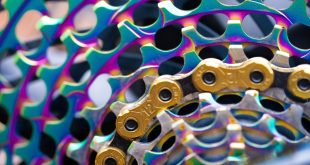Manhattan Scientifics, Inc. of America told its investors it had been issued with U.S. Patent No. 6,808,834 Koschany — Fuel Cell Stack With Cooling Fins and Use of Expanded Graphite in Fuel Cells.
Marvin Maslow, CEO of Manhattan Scientifics, said:
"As our economy actively begins to enter the fuel cell era, this patent on our NovArs fuel cell is potentially quite valuable for our company and our shareholders.
"Invented by Dr. Arthur Koschany, the NovArs fuel cell has been successfully demonstrated in a number of prototype pre-commercial situations. Smaller than a brick and weighing less than two pounds, the hydrogen-powered NovArs fuel cell is intended to power a bicycle or a motor scooter for several hundred miles without having to refuel depending on type of use, weight of rider, road conditions and the size of the fuel tank. Manhattan’s early prototype vehicles have already demonstrated approximately 100-mile drive ranges."
"We are currently aggressively pursuing our business plan to have the NovArs fuel cell manufactured for use on electric bicycles and scooters in Asia."
RELATED ARTICLES:
Wednesday 1st May 2002: Fuel cell technology inches forward
Manhattan Scientifics Inc., a US envelope-pusher specializing in alternative energy, and Aprilia, the Italian motorcycle manufacturer, unveiled a new fuel cell powered scooter yesterday at the International Paris Fair. It joins the Aprilia fuel cell bicycle, one of Time Magazine’s ‘Inventions of the Year’ in 2001
The scooter is an electric concept vehicle called MOJITO FC. Powered by Manhattan Scientifics’ new 3000 watt fuel cell, the scooter is silent, pollution-free and ideal for urban use, said Aprilia.
Fuelled by hydrogen, it’s claimed production models should be capable of covering 120 miles with a single fueling at a top speed of at least 35 miles an hour.
The MOJITO FC is the second Aprilia fuel cell powered concept vehicle developed with Manhattan Scientifics. The two companies previously developed the Aprilia ENJOY FC, a concept fuel cell powered bicycle, seen above being ridden by five times Tour de France winner Miguel Indurain.
Manhattan Scientifics developed the vehicles with Aprilia to interest manufacturers and other parties in the advantages of fuel cell powered personal transportation.
The new scooter uses Manhattan Scientifics’ proprietary fuel cell technology developed by its German unit, NovArs GmbH. The fuel cell is a hydrogen/air system using advanced materials and unique technologies to minimize size and weight.
Manhattan CEO Marvin Maslow said: "We believe our NovArs technology sets the benchmark as the smallest size and lightest weight engine in the budding fuel cell industry. This means our patented engine has particular application with portables — everything from laptop computers to power tools to bicycles, scooters, golf carts, wheelchairs, and small boats. Imagine driving the new MOJITO scooter in total silence for 120 miles on a single fueling of inexpensive hydrogen.
"Industry experts believe it might be a decade before we see true mass production and mass purchased fuel cell cars on our roads. But this need not be true for other smaller forms of fuel-cell-driven personal transportation."
And this includes, electrically assisted bicycles.
In late 2001, Time Magazine said: "Fuel-cell technology, which uses pollution free hydrogen gas to generate an electric current, could ignite electric bike sales. The first prototype, from Italian bike maker Aprilia, stores compressed hydrogen in a 2-liter canister housed in the frame. With a top speed of 20 mph, the bike won’t win the Tour de France. But it weighs 20 percent less than regular electrics and travels twice as far, about 43 miles before it needs more gas. Now that’s cool."
The article estimates the bike will be available in 2003 for approximately $2300.
Dr. Arthur Koschany, Manhattan Scientific’s chief fuel cell scientist and head of the NovArs unit, said: "The Aprilia fuel cell bicycle has a range slightly over 50 miles. The fuel cell itself weighs less than two pounds, operates silently and produces only pure water as a byproduct. The refueling of the hydrogen container can be done in a minute and in large quantities the fuel cell system can be produced inexpensively, meaning that an entry into the Asia market is a very viable possibility."
Tuesday 20th June 2000: Lead is dead, say hydrogen-powered biking boffins
A US company has developed a pollution-free polymer electrolyte fuel cell that uses hydrogen and air to produce electric power. The company has successfully powered a bicycle using the new battery
Manhattan Scientifics, Inc. has completed initial testing of the Hydrocycle, a fuel cell powered bicycle. The prototype uses Manhattan Scientifics’ proprietary power technology developed by the company’s NovArs unit in Passau, Germany.
"Our fuel cell powered bicycle offers a strong value proposition when compared to today’s battery powered bicycles, said Jack Harrod, Manhattan Scientifics’ chief operating officer.
The Hydrocycle is also wonderfully quiet and gives off no
emissions other than a small amount of water vapour. In the noisy, polluted cities of Asia and elsewhere in the world, we believe the Hydrocycle could make an enormous difference in the quality of life of the people in those cities. We have opened discussions with industry leaders in the powered bicycle and scooter segments about possible applications."
The cylindrical-shaped fuel cell stack, which powers the Hydrocycle, weighs 780 grams, and delivers 670 watts of power to a hub motor. The hydrogen fuel is contained in a two-litre carbon fibre reinforced pressure vessel located behind the bicycle seat. This provides the cyclist with a driving range of up to 70-100 km (flat surface) at a top speed of 30 km/h.
In production, the fuel tank could be integrated into the frame of the bicycle, says a press release from Manhattan Scientifics and claims to be far superior to existing battery technologies:
In comparison to conventional battery systems, the complete HYDROCYCLE(TM) fuel cell system has about seven times more energy density than lead acid batteries (30 w/kg) and more than three times the energy density of NiMeH batteries (60 w/kg).
Dr. Arthur Koschany, founder and chief scientist of NovArs, said: "We decided to build the bicycle to demonstrate the key features of our technology — the lightest weight, most compact stack for a given power.
Manhattan Scientifics’ CEO Marvin Maslow said: "The Japan Cycle Press estimates there will be 1 billion electric bikes on the roads by the year 2020 — mostly in Asia with smaller niche markets in Europe and the United States. In Asian countries such as India, massive amounts of goods are transported every day by scooters driven by heavily polluting two-cycle
engines. These societies are literally choking on gas and diesel fumes.
"Electric powered bikes and scooters could provide significant improvements for their environments and consequently their economies. In his book Bike Cult, author David Perry notes that in China, India and Japan alone there are currently 405 million bicycles in use. He says that in Tianjin, China an estimated 77% of daily trips are made by bicycle. In Shenyang, China that number is 65% and in Beijing 48%. This clearly suggests the potential for a low cost, environmentally clean, fuel cell powered bicycle."
 BikeBiz Bicycle and cycling retail news
BikeBiz Bicycle and cycling retail news



